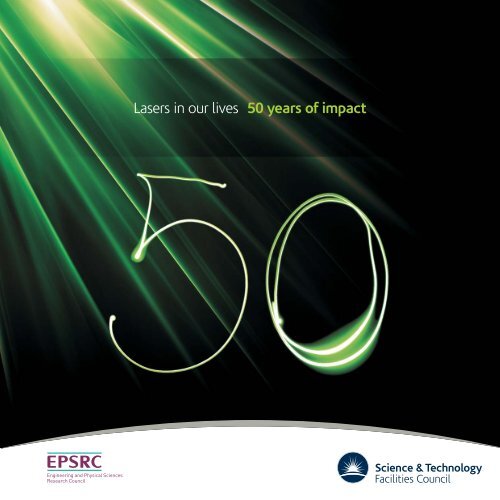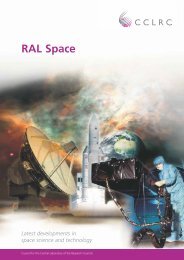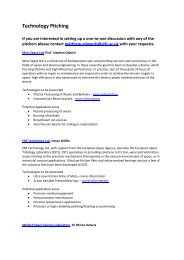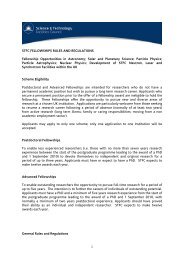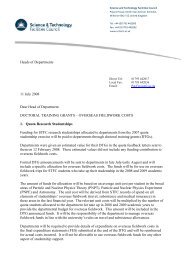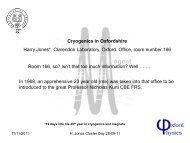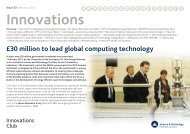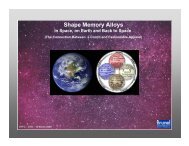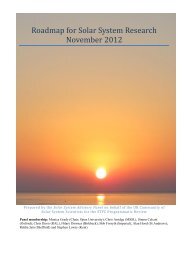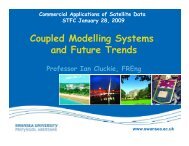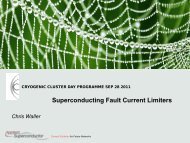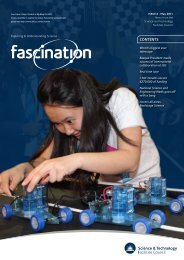Lasers in our lives â 50 years of impact - Science & Technology ...
Lasers in our lives â 50 years of impact - Science & Technology ...
Lasers in our lives â 50 years of impact - Science & Technology ...
Create successful ePaper yourself
Turn your PDF publications into a flip-book with our unique Google optimized e-Paper software.
<strong>Lasers</strong> <strong>in</strong> <strong>our</strong> <strong>lives</strong> <strong>50</strong> <strong>years</strong> <strong>of</strong> <strong>impact</strong>
<strong>Lasers</strong> <strong>in</strong> <strong>our</strong> <strong>lives</strong> <strong>50</strong> <strong>years</strong> <strong>of</strong> <strong>impact</strong><br />
The <strong>in</strong>formation <strong>in</strong> this brochure is just a sample <strong>of</strong> the significant social and<br />
economic <strong>impact</strong> that lasers have had on <strong>our</strong> <strong>lives</strong> over the past <strong>50</strong> <strong>years</strong>.<br />
Because <strong>of</strong> the collaborative nature <strong>of</strong> research many <strong>of</strong> the experiments,<br />
projects, R&D programmes, and applications that have led to the ubiquitous<br />
nature <strong>of</strong> lasers, have been jo<strong>in</strong>t efforts between research councils,<br />
academia and <strong>in</strong>dustry.<br />
The <strong>Science</strong> and <strong>Technology</strong> Facilities Council (STFC), through its Central<br />
Laser Facility based at the Rutherford Appleton Laboratory (RAL), cont<strong>in</strong>ues<br />
to play a lead<strong>in</strong>g role <strong>in</strong> the development <strong>of</strong> lasers and operation <strong>of</strong> highpower<br />
laser facilities.<br />
The Eng<strong>in</strong>eer<strong>in</strong>g and Physical <strong>Science</strong>s Research Council (EPSRC) is also a<br />
key funder <strong>of</strong> laser research and technology <strong>in</strong> the UK.<br />
This brochure was co-funded by STFC and EPSRC.<br />
Project Manager: Connor Curtis, STFC<br />
Design and layout: Ampersand Design<br />
Production: STFC Media Services
Introduction<br />
What are lasers?<br />
Light<br />
Amplification by<br />
Stimulated<br />
Emission <strong>of</strong><br />
Radiation<br />
1<br />
<strong>Lasers</strong> are concentrated<br />
beams <strong>of</strong> electromagnetic<br />
radiation (light) travell<strong>in</strong>g <strong>in</strong><br />
a particular direction.<br />
The def<strong>in</strong><strong>in</strong>g properties <strong>of</strong> laser<br />
light are that the light waves are<br />
coherent (all travell<strong>in</strong>g <strong>in</strong> harmony<br />
with one another) and that they<br />
are usually <strong>of</strong> one wavelength,<br />
or col<strong>our</strong>.<br />
By harness<strong>in</strong>g these properties <strong>in</strong> a<br />
device that reflects light back and<br />
forth through a special material, it<br />
is possible to generate an<br />
amplified light s<strong>our</strong>ce, or laser.<br />
Such light can be concentrated <strong>in</strong><br />
time and space to create truly<br />
extreme conditions, or be used to<br />
provide exquisite imag<strong>in</strong>g and<br />
analysis capability across a wide<br />
range <strong>of</strong> applications.<br />
A brief history<br />
The conception <strong>of</strong> the laser traces back to a theory proposed by<br />
Albert E<strong>in</strong>ste<strong>in</strong> <strong>in</strong> 1917.<br />
It was E<strong>in</strong>ste<strong>in</strong>’s theoretical understand<strong>in</strong>g <strong>of</strong> the <strong>in</strong>teractions between light<br />
and matter that paved the way for the first laser. However, it was not until<br />
1960 that the first work<strong>in</strong>g optical ruby laser was built by Theodore<br />
Maiman. Over the past <strong>50</strong> <strong>years</strong>, the laser has evolved considerably, and<br />
many new varieties have been developed. Due to their extreme versatility,<br />
lasers have become <strong>in</strong>valuable tools across a multitude <strong>of</strong> applications.<br />
Where STFC fits <strong>in</strong>to the picture<br />
The UK excels <strong>in</strong> research us<strong>in</strong>g and<br />
creat<strong>in</strong>g high-power lasers.<br />
STFC’s Central Laser Facility (CLF),<br />
sited at the Rutherford Appleton<br />
Laboratory has been at the forefront<br />
<strong>of</strong> <strong>in</strong>novative laser technology and<br />
research for more than 30 <strong>years</strong>.<br />
This brochure demonstrates the far<br />
reach<strong>in</strong>g <strong>impact</strong>s that lasers have on<br />
<strong>our</strong> <strong>lives</strong>, and highlights some <strong>of</strong> the<br />
key contributions made by STFC <strong>in</strong> the<br />
field <strong>of</strong> laser research dur<strong>in</strong>g the past<br />
30 <strong>years</strong>.<br />
Introduction
Why do we care about lasers?<br />
2<br />
Today, lasers<br />
<strong>impact</strong> almost<br />
every aspect<br />
<strong>of</strong> life…<br />
…from medic<strong>in</strong>e to<br />
manufactur<strong>in</strong>g, from<br />
communications to<br />
measurement, and from<br />
research and analysis to<br />
enterta<strong>in</strong>ment. This is<br />
ironic for a device that<br />
was <strong>in</strong>itially described as<br />
a ‘solution look<strong>in</strong>g for a<br />
problem’. In fact, dur<strong>in</strong>g<br />
its first <strong>50</strong> <strong>years</strong>, the<br />
laser has been noth<strong>in</strong>g<br />
short <strong>of</strong> revolutionary!<br />
We can only wonder<br />
what the next <strong>50</strong> <strong>years</strong><br />
will br<strong>in</strong>g.<br />
fact<br />
Estimates suggest<br />
that the world market<br />
for lasers <strong>in</strong> 2007 alone<br />
was worth more than<br />
£4Bn!<br />
Measurement<br />
and analysis<br />
Measurement and analysis<br />
have been transformed by<br />
the laser. Surveyors use<br />
lasers to mark out roads<br />
and construction sites, the<br />
military use them to<br />
determ<strong>in</strong>e the position <strong>of</strong><br />
targets and even NASA<br />
has utilised lasers to<br />
measure the distance <strong>of</strong><br />
the Moon from the Earth.<br />
Laser analysis <strong>of</strong> chemical<br />
and physical structures<br />
has allowed factories to<br />
manage quality control<br />
efficiently. Laser<br />
techniques have been<br />
adopted by alum<strong>in</strong>iummanufactur<strong>in</strong>g<br />
plants to<br />
monitor accurately the<br />
proportion <strong>of</strong> constituent<br />
metals <strong>in</strong> alloys. They also<br />
play a crucial role <strong>in</strong> the<br />
<strong>in</strong>spection <strong>of</strong><br />
pharmaceuticals.<br />
➜ SEE PAGE 4<br />
Defence and<br />
national security<br />
The world is on high alert<br />
for potential terrorist<br />
attacks, and security is <strong>of</strong><br />
high priority. Detect<strong>in</strong>g<br />
explosives and<br />
biochemical hazards are<br />
just a few examples <strong>of</strong><br />
how lasers can strengthen<br />
<strong>our</strong> national security.<br />
➜ SEE PAGE 6<br />
fact<br />
The total number<br />
<strong>of</strong> laser patents<br />
issued s<strong>in</strong>ce its<br />
<strong>in</strong>vention is well<br />
over <strong>50</strong>,000<br />
Medic<strong>in</strong>e<br />
and health<br />
Only one year after its<br />
<strong>in</strong>vention, the laser was<br />
be<strong>in</strong>g applied <strong>in</strong> a<br />
medical procedure. This<br />
happened <strong>in</strong> December<br />
1961 at the Columbia-<br />
Presbyterian Hospital,<br />
where a ruby laser was<br />
used to destroy an eye<br />
tum<strong>our</strong>. Today, lasers are<br />
commonly employed <strong>in</strong><br />
most medical discipl<strong>in</strong>es,<br />
<strong>in</strong>clud<strong>in</strong>g dermatology,<br />
dentistry, cardiology,<br />
neurosurgery and eye<br />
surgery, because <strong>of</strong> their<br />
ability to deliver highprecision<br />
treatments,<br />
whilst rema<strong>in</strong><strong>in</strong>g<br />
m<strong>in</strong>imally <strong>in</strong>vasive.<br />
Laser-based therapies<br />
and diagnostic methods<br />
represent an area <strong>of</strong> huge<br />
future potential.<br />
➜ SEE PAGE 8
<strong>Lasers</strong> <strong>in</strong> <strong>our</strong> <strong>lives</strong><br />
<strong>50</strong> <strong>years</strong> <strong>of</strong> <strong>impact</strong><br />
3<br />
Energy<br />
<strong>Lasers</strong> can generate<br />
extreme pressures and<br />
temperatures, and so can be<br />
used to ignite nuclear fusion<br />
– the same process that<br />
powers <strong>our</strong> Sun.<br />
Research <strong>in</strong>to laser-driven<br />
fusion is currently<br />
underway and promises to<br />
address <strong>our</strong> <strong>in</strong>creas<strong>in</strong>g<br />
demands for energy.<br />
In addition, scientists are<br />
exploit<strong>in</strong>g lasers <strong>in</strong> the<br />
development <strong>of</strong> solar cells.<br />
➜ SEE PAGE 10<br />
Communications<br />
Long-distance<br />
telecommunications and<br />
broadband <strong>in</strong>ternet both<br />
depend on the transmission<br />
<strong>of</strong> light pulses along optical<br />
fibres. These light pulses<br />
are both generated and<br />
relayed via lasers. This<br />
revolutionary method <strong>of</strong><br />
communication is replac<strong>in</strong>g<br />
less efficient copper wirebased<br />
networks and is the<br />
foundation <strong>of</strong> the <strong>in</strong>ternet<br />
and <strong>in</strong>formation age.<br />
➜ SEE PAGE 12<br />
Environment<br />
and climate<br />
Climate change is one <strong>of</strong><br />
<strong>our</strong> most immediate<br />
challenges. Deforestation<br />
and the burn<strong>in</strong>g <strong>of</strong> fossil<br />
fuels are the likely causes<br />
for the <strong>in</strong>creased<br />
concentrations <strong>of</strong><br />
greenhouse gases <strong>in</strong> the<br />
Earth’s atmosphere.<br />
<strong>Lasers</strong> can be used to<br />
analyse the concentrations<br />
<strong>of</strong> these gases and even to<br />
monitor their effects on<br />
ecosystems.<br />
➜ SEE PAGE 14<br />
Manufactur<strong>in</strong>g<br />
<strong>Lasers</strong> are employed across<br />
the manufactur<strong>in</strong>g <strong>in</strong>dustry<br />
as tools capable <strong>of</strong><br />
deliver<strong>in</strong>g <strong>in</strong>tense cutt<strong>in</strong>g<br />
or weld<strong>in</strong>g power with<br />
high precision. Their ability<br />
to manipulate and<br />
transform materials makes<br />
them ideal for the<br />
automobile, computer and<br />
cloth<strong>in</strong>g <strong>in</strong>dustries – to<br />
name but a few. In fact, it<br />
is difficult to f<strong>in</strong>d a modern<br />
consumer product that has<br />
not seen a laser dur<strong>in</strong>g its<br />
manufactur<strong>in</strong>g.<br />
➜ SEE PAGE 16<br />
Why do we care about lasers?
Measurement and analysis<br />
4<br />
Measur<strong>in</strong>g the distance<br />
to the Moon<br />
Thanks to special mirrors left beh<strong>in</strong>d by<br />
Apollo astronauts, the distance from the<br />
Earth to the Moon is known with a<br />
precision <strong>of</strong> millimetres!<br />
Laser light fired from the Earth is reflected<br />
back by these mirrors (lunar retro-reflectors)<br />
and by accurately record<strong>in</strong>g the time the<br />
light takes to travel, the distance to the<br />
Moon can be determ<strong>in</strong>ed.<br />
Photo: ESA<br />
Do lasers hold the key to unlock<strong>in</strong>g<br />
the secrets <strong>of</strong> the Universe?<br />
The very fabric <strong>of</strong> space and time cont<strong>in</strong>ually undergoes subtle<br />
‘ripples’ that carry messages <strong>of</strong> astronomical events. These<br />
<strong>in</strong>clude the mergers <strong>of</strong> massive black holes, neutron stars and<br />
even the aftermath <strong>of</strong> the Big Bang.<br />
The ‘ripples’, or gravitational waves, were predicted almost a century<br />
ago by E<strong>in</strong>ste<strong>in</strong>’s General Theory <strong>of</strong> Relativity. Detect<strong>in</strong>g and study<strong>in</strong>g<br />
them will provide an entirely new way to observe and understand<br />
the Universe.<br />
The Laser Interferometer Space Antenna (LISA) experiment aims to do<br />
just that. An ESA/NASA jo<strong>in</strong>t venture, LISA will consist <strong>of</strong> three<br />
separate, identical spacecraft fly<strong>in</strong>g <strong>in</strong> an equilateral triangle<br />
arrangement, with ‘laser arms’<br />
about 5 million kilometres long.<br />
T<strong>in</strong>y changes <strong>in</strong> the relative length<br />
<strong>of</strong> these arms caused by gravity<br />
waves will be measured by<br />
precisely monitor<strong>in</strong>g the<br />
separation between each<br />
spacecraft. From study<strong>in</strong>g the<br />
shape and tim<strong>in</strong>g <strong>of</strong> these waves,<br />
the LISA research team will be<br />
able to <strong>in</strong>fer <strong>in</strong>formation about<br />
the astronomical systems that<br />
emitted them, such as their<br />
nature and evolution.<br />
Photo: ESA (C.Vijoux) Photo: ESA (NASA)
<strong>Lasers</strong> <strong>in</strong> <strong>our</strong> <strong>lives</strong><br />
<strong>50</strong> <strong>years</strong> <strong>of</strong> <strong>impact</strong><br />
5<br />
Us<strong>in</strong>g lasers to<br />
measure gravity<br />
As well as be<strong>in</strong>g able to generate<br />
extremely high temperatures, lasers<br />
can also be used to cool down<br />
atoms to temperatures close<br />
to absolute zero (-273°C).<br />
When laser cool<strong>in</strong>g is<br />
comb<strong>in</strong>ed with another<br />
technique called magnetooptical<br />
trapp<strong>in</strong>g, it is possible to<br />
produce samples <strong>of</strong> trapped, slowmov<strong>in</strong>g,<br />
neutral atoms that are close to<br />
absolute zero.<br />
Follow<strong>in</strong>g research carried out by US<br />
physicists, scientists at STFC are now<br />
work<strong>in</strong>g on a device that <strong>in</strong>corporates a<br />
magneto-optical trap <strong>in</strong>to a system<br />
capable <strong>of</strong> measur<strong>in</strong>g gravity to high<br />
accuracy. By ‘dropp<strong>in</strong>g’ these cold atoms<br />
down a vertical vacuum tube, precise<br />
gravitational measurements can be made.<br />
Such devices have potential applications<br />
<strong>in</strong> geophysics and <strong>in</strong> oil exploration.<br />
<strong>Lasers</strong> <strong>in</strong> archaeometry<br />
and art<br />
Non-<strong>in</strong>vasive laser diagnostic techniques have been used to<br />
identify, date and analyse ancient artefacts, rocks and<br />
d<strong>in</strong>osaur fossils.<br />
Archaeologists have also applied laser-scann<strong>in</strong>g techniques to<br />
sites such as Stonehenge (Wiltshire, UK), lead<strong>in</strong>g to the<br />
discovery <strong>of</strong> lost ancient art.<br />
In addition, lasers have<br />
been employed to scan<br />
and survey ancient sites,<br />
allow<strong>in</strong>g archaeologists<br />
to generate 3-D<br />
images and visualise<br />
their excavations<br />
dur<strong>in</strong>g its various<br />
stages. <strong>Lasers</strong> are also<br />
be<strong>in</strong>g <strong>in</strong>creas<strong>in</strong>gly<br />
used <strong>in</strong> the<br />
exam<strong>in</strong>ation and<br />
conservation <strong>of</strong><br />
pa<strong>in</strong>t<strong>in</strong>gs and<br />
artwork.<br />
Measurement and analysis
Defence and national security<br />
6<br />
Detect<strong>in</strong>g chemicals<br />
before it’s too late<br />
See<strong>in</strong>g through<br />
opaque bottles<br />
A system capable <strong>of</strong> remotely<br />
identify<strong>in</strong>g, quantify<strong>in</strong>g and<br />
locat<strong>in</strong>g the release <strong>of</strong> volatile<br />
chemicals would be <strong>in</strong>valuable for<br />
security applications.<br />
Gas-phase chemicals, like the<br />
volatiles <strong>of</strong>ten emitted by explosives,<br />
possess unique spectral f<strong>in</strong>gerpr<strong>in</strong>ts<br />
that allow remote detection us<strong>in</strong>g<br />
optical techniques. A real-time stand<strong>of</strong>f<br />
detection system that exploits<br />
these f<strong>in</strong>gerpr<strong>in</strong>ts could provide<br />
improved security at airports and<br />
other civil <strong>in</strong>frastructures, and even<br />
on the battlefield.<br />
STFC scientists and partners are<br />
currently <strong>in</strong>vestigat<strong>in</strong>g novel laserbased<br />
technologies for stand-<strong>of</strong>f<br />
detection. Us<strong>in</strong>g cont<strong>in</strong>uous<br />
frequency-tuneable laser s<strong>our</strong>ces that<br />
are extremely compact and optimised<br />
for chemical detection, the team is<br />
develop<strong>in</strong>g novel <strong>in</strong>struments with<br />
unprecedented spatial resolution,<br />
chemical selectivity and compactness.<br />
Spatially Offset Raman<br />
Spectroscopy (SORS), is a new non<strong>in</strong>vasive<br />
spectroscopy technique<br />
developed at STFC’s ultrafast laser<br />
facility. It can determ<strong>in</strong>e the<br />
composition <strong>of</strong> materials hidden<br />
beh<strong>in</strong>d or with<strong>in</strong> other layers, such<br />
as a liquid concealed <strong>in</strong> an opaque<br />
bottle or conta<strong>in</strong>er.<br />
The technique has been patented and<br />
developed via a sp<strong>in</strong>-out company<br />
called Cobalt Light Systems, which<br />
seeks to exploit the technique’s widerang<strong>in</strong>g<br />
potential applications. These<br />
<strong>in</strong>clude a new capability for detect<strong>in</strong>g<br />
hidden explosives and illicit drugs, as<br />
well as assess<strong>in</strong>g the quality and<br />
authenticity <strong>of</strong> medic<strong>in</strong>es, and<br />
potentially diagnos<strong>in</strong>g bone diseases<br />
and cancer non-<strong>in</strong>vasively.
<strong>Lasers</strong> <strong>in</strong> <strong>our</strong> <strong>lives</strong><br />
<strong>50</strong> <strong>years</strong> <strong>of</strong> <strong>impact</strong><br />
7<br />
Towards a new generation<br />
<strong>of</strong> computers<br />
An experiment at STFC’s ISIS facility<br />
exploits a laser to assist <strong>in</strong> provid<strong>in</strong>g a<br />
unique beam <strong>of</strong> very low- energy muons.<br />
These fundamental particles act as t<strong>in</strong>y<br />
magnets, prob<strong>in</strong>g the magnetic properties<br />
<strong>of</strong> target materials at the scale <strong>of</strong> a<br />
nanometre (one billionth <strong>of</strong> a metre).<br />
This research could help, for example, <strong>in</strong><br />
characteris<strong>in</strong>g semiconductor devices for<br />
the next generation <strong>of</strong> computers, which<br />
will make use <strong>of</strong> an emerg<strong>in</strong>g technology<br />
called sp<strong>in</strong>tronics. Current electronic<br />
devices such as transistors work by<br />
transferr<strong>in</strong>g electrons. However, exploit<strong>in</strong>g<br />
the electron’s sp<strong>in</strong> has the potential to lead<br />
to faster and more powerful <strong>in</strong>formation<br />
process<strong>in</strong>g and storage. Sp<strong>in</strong>tronics is<br />
already used <strong>in</strong> the read-heads <strong>of</strong> highcapacity<br />
hard disks.<br />
In 2007, a key scientific discovery<br />
fundamental to sp<strong>in</strong>tronics – giant<br />
magnetoresistance – was recognised<br />
through the award <strong>of</strong> the Nobel Prize<br />
for Physics.<br />
Defence and national security
Medic<strong>in</strong>e and health<br />
8<br />
How laser imag<strong>in</strong>g can<br />
help diagnose cancer<br />
Shr<strong>in</strong>k<strong>in</strong>g accelerators<br />
Imag<strong>in</strong>e a world <strong>in</strong> which doctors can prescribe medication<br />
that is specifically tailored to a person’s DNA f<strong>in</strong>gerpr<strong>in</strong>t. It is<br />
guaranteed to be effective aga<strong>in</strong>st an <strong>in</strong>dividual’s cancer,<br />
with m<strong>in</strong>imal side-effects.<br />
Scientists work<strong>in</strong>g at STFC’s <strong>Lasers</strong> for <strong>Science</strong> Facility are at the<br />
forefront <strong>of</strong> research aimed at tackl<strong>in</strong>g diseases such as lung and<br />
breast cancer. A technique that col<strong>our</strong>-codes ‘misbehav<strong>in</strong>g’ prote<strong>in</strong><br />
molecules with a fluorescent dye and then uses lasers to illum<strong>in</strong>ate<br />
these molecules, caus<strong>in</strong>g them to glow, provides an <strong>in</strong>sight <strong>in</strong>to<br />
their behavi<strong>our</strong> dur<strong>in</strong>g the onset <strong>of</strong> disease. Researchers can then<br />
use sophisticated computer methods to build up a detailed 3-D<br />
picture that reveals the underly<strong>in</strong>g bio-molecular <strong>in</strong>teractions<br />
lead<strong>in</strong>g to disease.<br />
The <strong>in</strong>formation obta<strong>in</strong>ed from this novel use <strong>of</strong> lasers will be a<br />
crucial step towards a future <strong>of</strong> personalised medic<strong>in</strong>e.<br />
By smash<strong>in</strong>g together beams <strong>of</strong> high-energy<br />
elementary particles <strong>in</strong> accelerators and<br />
observ<strong>in</strong>g the debris, researchers can better<br />
understand the structure <strong>of</strong> matter and the<br />
forces <strong>of</strong> nature at a fundamental level. In<br />
addition, beams <strong>of</strong> energetic particles are<br />
useful tools for biological, nanotechnology and<br />
chemistry research.<br />
STFC scientists are <strong>in</strong>volved <strong>in</strong> <strong>in</strong>vestigat<strong>in</strong>g and<br />
develop<strong>in</strong>g a new generation <strong>of</strong> radiation s<strong>our</strong>ces<br />
that aim to accelerate particles us<strong>in</strong>g lasers. This<br />
technology has the potential to reduce the size <strong>of</strong><br />
conventional accelerators to fit on a laboratory<br />
bench-top, result<strong>in</strong>g <strong>in</strong> significantly reduced costs.<br />
These potentially portable mach<strong>in</strong>es would also<br />
<strong>of</strong>fer a host <strong>of</strong> medical, <strong>in</strong>dustrial and security<br />
applications, <strong>in</strong>clud<strong>in</strong>g cancer therapy, the<br />
rapid detection <strong>of</strong> hidden explosives and<br />
improved quality control <strong>in</strong> the fabrication <strong>of</strong><br />
semiconductors.
<strong>Lasers</strong> <strong>in</strong> <strong>our</strong> <strong>lives</strong><br />
<strong>50</strong> <strong>years</strong> <strong>of</strong> <strong>impact</strong><br />
9<br />
Detect<strong>in</strong>g<br />
eye disease<br />
By scann<strong>in</strong>g laser light<br />
back and forth across the<br />
ret<strong>in</strong>a, high-resolution,<br />
cross-sectional images can<br />
be taken, which can be<br />
comb<strong>in</strong>ed <strong>in</strong>to a 3-D<br />
picture <strong>of</strong> the ret<strong>in</strong>a.<br />
This novel technique –<br />
optical coherence<br />
tomography (OCT) – can<br />
help ophthalmologists to<br />
detect the subtle changes<br />
that occur <strong>in</strong> ret<strong>in</strong>al disease.<br />
fact<br />
More than 100,000<br />
laser procedures to<br />
correct vision are<br />
performed annually<br />
<strong>in</strong> the UK – a figure<br />
that is on the<br />
<strong>in</strong>crease!<br />
Cholesterol test<strong>in</strong>g<br />
Us<strong>in</strong>g technology developed at STFC’s<br />
Daresbury Laboratory <strong>in</strong> Cheshire, the<br />
company L3 <strong>Technology</strong> has used lasers to<br />
develop and patent a highly accurate<br />
cholesterol test that is more precise and<br />
cost-effective than other similar test<strong>in</strong>g<br />
kits currently available.<br />
Current ‘over-the-counter’ cholesterol test-kits<br />
do not dist<strong>in</strong>guish between the different types<br />
<strong>of</strong> cholesterol considered ‘good’ or ‘bad’ from<br />
a health po<strong>in</strong>t <strong>of</strong> view. Exist<strong>in</strong>g laboratory<br />
tests take a m<strong>in</strong>imum <strong>of</strong> three days to<br />
generate adequate results.<br />
The L3 <strong>Technology</strong> test works by tagg<strong>in</strong>g<br />
compounds with a fluorescent marker that is<br />
subsequently illum<strong>in</strong>ated with an <strong>in</strong>tense light<br />
s<strong>our</strong>ce. The <strong>in</strong>tensity <strong>of</strong> fluorescence<br />
quantifies the type and amount <strong>of</strong> cholesterol<br />
that is present <strong>in</strong> the sample.<br />
The company’s ultimate goal is to produce a<br />
range <strong>of</strong> tests that will be conveniently<br />
available at y<strong>our</strong> GP’s surgery, sav<strong>in</strong>g both<br />
time and money.<br />
Tattoo removal<br />
Tattoos consist <strong>of</strong> large<br />
clumps <strong>of</strong> pigment scattered<br />
through the lower layer <strong>of</strong><br />
sk<strong>in</strong>. Because <strong>of</strong> their size<br />
the body is unable to<br />
remove these clumps, so<br />
<strong>in</strong>stead, seals them <strong>of</strong>f with<br />
a protective fibrous barrier.<br />
Laser therapy works by<br />
break<strong>in</strong>g down this fibrous<br />
barrier, allow<strong>in</strong>g the pigment<br />
to disperse <strong>in</strong>to smaller pieces,<br />
which the body’s natural<br />
defences can slowly remove.<br />
Medic<strong>in</strong>e and health
Energy<br />
10<br />
E = mc 2<br />
E<strong>in</strong>ste<strong>in</strong>’s famous equation,<br />
E = mc 2 , tells us that energy and<br />
matter are <strong>in</strong>terchangeable,<br />
such that even a small amount<br />
<strong>of</strong> matter can potentially be<br />
converted <strong>in</strong>to a large amount<br />
<strong>of</strong> energy.<br />
Nuclear fusion is Nature’s way <strong>of</strong><br />
releas<strong>in</strong>g some <strong>of</strong> this energy<br />
and is the process that drives the<br />
Sun and other stars. Here on<br />
Earth, atomic nuclei such as<br />
those <strong>of</strong> hydrogen isotopes,<br />
deuterium and tritium, can be<br />
fused <strong>in</strong>to heavier nuclei such as<br />
helium, releas<strong>in</strong>g a huge amount<br />
<strong>of</strong> energy <strong>in</strong> the process. Fusion<br />
has the potential to address <strong>our</strong><br />
<strong>in</strong>creas<strong>in</strong>g energy needs,<br />
provid<strong>in</strong>g a safe and effectively<br />
<strong>in</strong>exhaustible energy supply, <strong>in</strong><br />
an environmentally susta<strong>in</strong>able<br />
manner.<br />
Benefits <strong>of</strong><br />
laser fusion<br />
Plentiful fuel<br />
Laser-driven fusion could supply the world with<br />
an abundant, effectively limitless fuel supply.<br />
Energy security<br />
The required fuel is readily available <strong>in</strong><br />
seawater.<br />
Clean energy<br />
Laser-driven fusion produces no greenhouse gas<br />
emissions and thus has a low environmental<br />
<strong>impact</strong>. Also, unlike nuclear power stations,<br />
there is no long-lived radioactivity, thereby<br />
reduc<strong>in</strong>g health risks.<br />
Creation <strong>of</strong> jobs<br />
The progression <strong>of</strong> laser-driven fusion, from<br />
pro<strong>of</strong>-<strong>of</strong>-pr<strong>in</strong>ciple to commercial exploitation,<br />
will require a comb<strong>in</strong>ation <strong>of</strong> specialised<br />
facilities and considerable scientific expertise.<br />
The construction <strong>of</strong> HiPER, the proposed<br />
European High Power laser Energy Research<br />
facility to demonstrate the feasibility <strong>of</strong> laserdriven<br />
fusion, would generate huge economic<br />
benefits both domestically and beyond. These<br />
<strong>in</strong>clude job creation and the capitalisation <strong>of</strong><br />
emerg<strong>in</strong>g sp<strong>in</strong>-<strong>of</strong>f technologies.<br />
Did you know?<br />
To give some idea<br />
<strong>of</strong> fusion’s potential:<br />
if successfully<br />
harnessed, just one<br />
cubic kilometre <strong>of</strong><br />
seawater would<br />
conta<strong>in</strong> enough<br />
deuterium fuel to<br />
provide energy that<br />
would exceed that<br />
from all the world’s<br />
oil reserves.
<strong>Lasers</strong> <strong>in</strong> <strong>our</strong> <strong>lives</strong><br />
<strong>50</strong> <strong>years</strong> <strong>of</strong> <strong>impact</strong><br />
11<br />
National Ignition<br />
Facility (NIF)<br />
NIF, situated at the<br />
Lawrence Livermore<br />
National Laboratory <strong>in</strong><br />
California <strong>in</strong> the US,<br />
hosts the world’s<br />
largest laser system.<br />
One <strong>of</strong> its missions is to<br />
<strong>in</strong>vestigate the feasibility<br />
<strong>of</strong> nuclear fusion. NIF<br />
aims to produce more<br />
energy from a fusion<br />
reaction than is used to<br />
<strong>in</strong>itiate the reaction. This<br />
would be a landmark<br />
demonstration <strong>of</strong> the<br />
pr<strong>in</strong>ciples <strong>of</strong> laser fusion.<br />
If successful, NIF ignition<br />
will be the launch-pad<br />
for the next generation<br />
<strong>of</strong> laser-fusion facilities<br />
such as HiPER.<br />
High Power laser Energy<br />
Research facility (HiPER)<br />
The next step towards fusion<br />
HiPER is a European collaborative project that<br />
represents the next step <strong>in</strong> the development <strong>of</strong><br />
laser fusion as an energy s<strong>our</strong>ce. It aims to bridge<br />
the gap between fusion research and harness<strong>in</strong>g<br />
fusion energy on an <strong>in</strong>dustrial scale. Operat<strong>in</strong>g<br />
rather like a car eng<strong>in</strong>e, the fuel will be <strong>in</strong>jected,<br />
then compressed and ignited via controlled laser<br />
pulses, creat<strong>in</strong>g the extreme conditions necessary<br />
for fusion. Unlike NIF, HiPER will <strong>in</strong>tegrate<br />
highrepetition rate technology and will be capable<br />
<strong>of</strong> repeat<strong>in</strong>g the ignition process an estimated five<br />
times per second.<br />
HiPER aims to demonstrate the full laser-fusion<br />
cycle, to provide the basis on which a new<br />
generation <strong>of</strong> electricity power stations<br />
could be built.<br />
Harvest<strong>in</strong>g<br />
sunsh<strong>in</strong>e<br />
Liv<strong>in</strong>g organisms depend on<br />
complex and <strong>of</strong>ten extremely<br />
efficient biochemical processes to<br />
harness, store and transport energy.<br />
By understand<strong>in</strong>g the underly<strong>in</strong>g<br />
mechanisms <strong>of</strong> the light-captur<strong>in</strong>g<br />
processes and energy transport<br />
<strong>in</strong>volved <strong>in</strong> photosynthesis, for<br />
example, researchers aim to<br />
develop similar systems that could<br />
be employed <strong>in</strong> the next generation<br />
<strong>of</strong> solar cells.<br />
Laser studies <strong>of</strong> how light triggers the<br />
movement <strong>of</strong> electrons through<br />
photosensitive biological structures<br />
are contribut<strong>in</strong>g to the scientific<br />
understand<strong>in</strong>g <strong>of</strong> solar-energy<br />
conversion at the molecular level.<br />
STFC scientists, <strong>in</strong> collaboration with<br />
partners, have performed<br />
experiments to measure the speed <strong>of</strong><br />
electron transfer through these<br />
molecular structures. They <strong>in</strong>volve<br />
fir<strong>in</strong>g a short laser pulse at a sample<br />
to stimulate the electron-transfer<br />
process, and then us<strong>in</strong>g a tuneable<br />
<strong>in</strong>frared laser to monitor how the<br />
system evolves <strong>in</strong> real time.<br />
Energy
Communications<br />
12<br />
Fibre optics<br />
Smart materials<br />
<strong>Lasers</strong> have revolutionised the way <strong>in</strong> which we<br />
communicate and are largely responsible for the advent <strong>of</strong><br />
the <strong>in</strong>formation age.<br />
Central to this new age <strong>of</strong> <strong>in</strong>formation transfer is the network<br />
<strong>of</strong> fibre optics that comprise the core <strong>of</strong> long-distance<br />
telephone communications and the <strong>in</strong>ternet. These networks<br />
rely on transmitt<strong>in</strong>g <strong>in</strong>formation through glass or plastic fibres<br />
via pulses <strong>of</strong> laser light. The light pulses are converted at their<br />
dest<strong>in</strong>ation <strong>in</strong>to electrical signals that provide the <strong>in</strong>formation.<br />
Fibre optical systems are rapidly replac<strong>in</strong>g the pre-exist<strong>in</strong>g<br />
copper-wire networks. Their flexibility, lower cost, higher<br />
efficiency, clearer signal and <strong>in</strong>creased capacity (to carry<br />
thousands <strong>of</strong> times the amount <strong>of</strong> <strong>in</strong>formation that copper<br />
wires can), make them a superior option for the<br />
telecommunications <strong>in</strong>dustry.<br />
A new type <strong>of</strong> laser actually based on specialised optical fibres<br />
is expected to have a range <strong>of</strong> important applications <strong>in</strong>clud<strong>in</strong>g<br />
biomedical microscopy and analysis, and quantum-<strong>in</strong>formation<br />
process<strong>in</strong>g.<br />
‘Smart’ materials possess properties<br />
that can be significantly changed by<br />
external stimuli. Examples <strong>of</strong> these<br />
properties <strong>in</strong>clude stress, temperature,<br />
moisture, pH, and electric or<br />
magnetic fields.<br />
Laser-enabled fibre-optic<br />
sensors that are sensitive to<br />
movement can be embedded<br />
<strong>in</strong>to certa<strong>in</strong> structures as<br />
monitor<strong>in</strong>g tools – for example,<br />
<strong>in</strong> the rotor blades <strong>of</strong> w<strong>in</strong>d<br />
turb<strong>in</strong>es, airplane and spacecraft<br />
structures, and bridges. They can<br />
<strong>in</strong>form <strong>of</strong> any structural<br />
changes or impend<strong>in</strong>g<br />
structural failure.
<strong>Lasers</strong> <strong>in</strong> <strong>our</strong> <strong>lives</strong><br />
<strong>50</strong> <strong>years</strong> <strong>of</strong> <strong>impact</strong><br />
13<br />
Information and communications<br />
technology<br />
Because they can carry large volumes <strong>of</strong><br />
<strong>in</strong>formation as pulses, lasers have been exploited<br />
extensively across the ICT <strong>in</strong>dustry. Examples <strong>of</strong><br />
areas where lasers are employed <strong>in</strong>clude:<br />
Optical storage<br />
<strong>Lasers</strong> read and write <strong>in</strong>formation encoded as<br />
microscopic ‘pits’ on CDs, DVDs, Blu-Ray and other<br />
storage media.<br />
Communication<br />
Laser-diode coupled fibre optics are be<strong>in</strong>g rolled out<br />
as the backbone <strong>of</strong> the high-speed <strong>in</strong>ternet,<br />
transform<strong>in</strong>g the way <strong>in</strong> which we <strong>in</strong>teract with<br />
each other and access high volume media such as<br />
movies, games and bus<strong>in</strong>ess <strong>in</strong>formation.<br />
Increas<strong>in</strong>g microprocessor speed<br />
Micro-lasers could provide a high-speed alternative<br />
to transistors. Optical signals can be used to connect<br />
<strong>in</strong>tegrated circuits at light speed, as well as<br />
provid<strong>in</strong>g the basis for a new generation <strong>of</strong><br />
holographic memory.<br />
See<strong>in</strong>g stars more clearly<br />
As light from distant stars and galaxies passes through<br />
the earth’s turbulent atmospheric layers, it becomes<br />
distorted. Astronomers have long sought to dim<strong>in</strong>ish<br />
these atmospheric effects so that ground-based<br />
observations can become clearer and more precise.<br />
One solution, which is becom<strong>in</strong>g <strong>in</strong>creas<strong>in</strong>gly employed by<br />
astronomers, is to create an artificial guide star by sh<strong>in</strong><strong>in</strong>g a<br />
laser <strong>in</strong>to the atmosphere. Atmospheric turbulence and<br />
changes <strong>in</strong> temperature cause the image <strong>of</strong> this laser on the<br />
sky to distort <strong>in</strong> a random fashion, it is also what makes<br />
stars appear to tw<strong>in</strong>kle <strong>in</strong> the night sky. Astronomers can<br />
utilise a system <strong>of</strong> adaptive optics to measure the distortions<br />
<strong>of</strong> this laser image and correct for any aberrations or<br />
deviations. By rapidly chang<strong>in</strong>g the surface <strong>of</strong> a deformable<br />
mirror via a computer system, these deviations can be<br />
compensated for, result<strong>in</strong>g <strong>in</strong> clearer astronomical images.<br />
Many <strong>of</strong> the world’s largest telescopes now use an artificial<br />
guide star <strong>in</strong> the form <strong>of</strong> a laser, which can be conveniently<br />
directed up <strong>in</strong>to the sky.<br />
The same adaptive optics technology is also applied to laser<br />
communication systems, such as the fibre optics network, to<br />
improve performance and efficiency.<br />
Communications
Environment and climate<br />
14<br />
<strong>Lasers</strong> to monitor and understand<br />
climate change<br />
Global cool<strong>in</strong>g<br />
Climate change and poor air quality are major challenges <strong>in</strong> a world<br />
<strong>of</strong> <strong>in</strong>creas<strong>in</strong>g <strong>in</strong>dustrialisation and urbanisation. Understand<strong>in</strong>g and<br />
monitor<strong>in</strong>g the Earth’s atmosphere is <strong>of</strong> crucial importance.<br />
Observ<strong>in</strong>g the atmosphere from space can provide a global view <strong>of</strong><br />
atmospheric composition and processes. An <strong>in</strong>novative research project,<br />
funded by the Natural Environment Research Council, called the Laser<br />
Heterodyne Radiometer (LHR) has <strong>in</strong>volved the development <strong>of</strong> a<br />
prototype <strong>in</strong>strument that could potentially be the forerunner <strong>of</strong> a new<br />
generation <strong>of</strong> satellite-based <strong>in</strong>frared monitor<strong>in</strong>g <strong>in</strong>struments. The LHR<br />
has been developed to provide a unique comb<strong>in</strong>ation <strong>of</strong> high spatial<br />
resolution (to locate gaseous emission s<strong>our</strong>ces and observe between<br />
clouds), high spectral resolution (to discrim<strong>in</strong>ate between types <strong>of</strong> gases),<br />
and high sensitivity to detect the t<strong>in</strong>iest concentrations <strong>of</strong> atmospheric<br />
constituents.<br />
Developed for Earth observation by a team <strong>of</strong> STFC scientists <strong>in</strong><br />
collaboration with partners, a prototype LHR <strong>in</strong>strument has recently<br />
been successfully demonstrated at ‘the Rutherford Appleton Laboratory’<br />
through ground-based measurements <strong>of</strong> atmospheric ozone, and is now<br />
be<strong>in</strong>g developed to monitor other key atmospheric trace gases.<br />
Clouds are considered to have a<br />
substantial <strong>impact</strong> on climate change<br />
because <strong>of</strong> their role <strong>in</strong> both absorb<strong>in</strong>g<br />
and reflect<strong>in</strong>g heat transferred through<br />
the atmosphere.<br />
Pollutants such as the organic compounds<br />
produced when fossil fuels are burnt, are<br />
believed to affect the formation and growth<br />
<strong>of</strong> water droplets <strong>in</strong> clouds.<br />
Scientists work<strong>in</strong>g at STFC have been able to<br />
ga<strong>in</strong> an <strong>in</strong>sight <strong>in</strong>to chemical reactions<br />
occurr<strong>in</strong>g on the surfaces <strong>of</strong> cloud droplets <strong>in</strong><br />
the atmosphere. Typical experiments <strong>in</strong>volve<br />
spray<strong>in</strong>g a mist <strong>of</strong> particles <strong>in</strong>to a model<br />
‘cloud chamber’ and us<strong>in</strong>g a microscope to<br />
focus a laser beam <strong>in</strong>to it. One <strong>of</strong> the droplets<br />
eventually f<strong>in</strong>ds its way <strong>in</strong>to the centre <strong>of</strong> the<br />
laser beam and is held <strong>in</strong> position via the<br />
<strong>in</strong>tense light-field pressure <strong>of</strong> the laser, which<br />
acts like ‘optical tweezers’. Analysis <strong>of</strong> laser<br />
light scattered by the droplet underp<strong>in</strong>s the<br />
development <strong>of</strong> complex computer models <strong>of</strong><br />
the atmosphere and contributes to improv<strong>in</strong>g<br />
<strong>our</strong> understand<strong>in</strong>g <strong>of</strong> climate change.
<strong>Lasers</strong> <strong>in</strong> <strong>our</strong> <strong>lives</strong><br />
<strong>50</strong> <strong>years</strong> <strong>of</strong> <strong>impact</strong><br />
15<br />
Monitor<strong>in</strong>g forests<br />
with lasers<br />
Important properties <strong>of</strong><br />
ecosystems such as those found <strong>in</strong><br />
tropical forests can be measured<br />
us<strong>in</strong>g a system <strong>of</strong> lasers attached<br />
to the underside <strong>of</strong> aircraft. Often<br />
covered with dense vegetation,<br />
these forests tend to be difficult<br />
to study on the ground or even<br />
with satellites.<br />
A comb<strong>in</strong>ation <strong>of</strong> advanced<br />
spectroscopic imag<strong>in</strong>g and laser<br />
remote-sens<strong>in</strong>g technologies can<br />
measure differences <strong>in</strong> ground<br />
elevation to an accuracy <strong>of</strong> with<strong>in</strong> a<br />
few <strong>in</strong>ches. This technology can<br />
provide <strong>in</strong>sights <strong>in</strong>to how changes <strong>in</strong><br />
climate and land use can affect the<br />
structure, composition and<br />
function<strong>in</strong>g <strong>of</strong> ecosystems.<br />
Us<strong>in</strong>g lasers to tackle<br />
oil spills<br />
Oil spills represent a major environmental risk, <strong>of</strong>ten tak<strong>in</strong>g<br />
many <strong>years</strong> to clean up. But, for some bacteria, oil is the<br />
perfect meal! By <strong>in</strong>troduc<strong>in</strong>g colonies <strong>of</strong> hydrocarbon-digest<strong>in</strong>g<br />
bacteria, it may be possible to lessen the <strong>impact</strong> <strong>of</strong> oil spills and<br />
clean them more efficiently.<br />
Researchers at STFC’s ‘<strong>Lasers</strong> for <strong>Science</strong> Facility’, <strong>in</strong> collaboration<br />
with scientists from the Centre for Ecology and Hydrology, have<br />
been assess<strong>in</strong>g the different types <strong>of</strong> bacteria that can digest<br />
hydrocarbons. By captur<strong>in</strong>g <strong>in</strong>dividual bacteria <strong>in</strong> laser optical<br />
tweezers and analys<strong>in</strong>g their spectra, scientists can establish<br />
whether the bacteria have broken down particular chemicals.<br />
Potential future applications <strong>of</strong> this research range from clean<strong>in</strong>g oil<br />
spills at sea, to the contam<strong>in</strong>ated land under petrol stations.<br />
Environment and climate
Manufactur<strong>in</strong>g<br />
16<br />
How are lasers used<br />
<strong>in</strong> manufactur<strong>in</strong>g?<br />
Build<strong>in</strong>g a car<br />
with lasers<br />
<strong>Lasers</strong> and<br />
semiconductors<br />
<strong>Lasers</strong> and<br />
packag<strong>in</strong>g<br />
➜ Laser cutt<strong>in</strong>g<br />
➜ Laser mark<strong>in</strong>g<br />
and engrav<strong>in</strong>g<br />
➜ Laser weld<strong>in</strong>g<br />
➜ Laser drill<strong>in</strong>g<br />
➜ Laser melt<strong>in</strong>g<br />
➜ Laser heat<br />
treat<strong>in</strong>g<br />
➜ Laser<br />
micromach<strong>in</strong><strong>in</strong>g<br />
➜ Laser solder<strong>in</strong>g<br />
➜ Laser surface<br />
treatment<br />
Innovative, highpower<br />
lasers have<br />
been utilised by the<br />
automotive <strong>in</strong>dustry<br />
s<strong>in</strong>ce the early<br />
1980s.<br />
Today, almost every<br />
modern vehicle will<br />
have had various<br />
encounters with<br />
lasers dur<strong>in</strong>g its<br />
manufactur<strong>in</strong>g – from<br />
cutt<strong>in</strong>g the airbag<br />
cloth, door l<strong>in</strong><strong>in</strong>g and<br />
keys to weld<strong>in</strong>g the<br />
body shell, anneal<strong>in</strong>g<br />
door spr<strong>in</strong>gs and<br />
mark<strong>in</strong>g tyres; lasers<br />
are absolutely<br />
essential tools <strong>in</strong><br />
modern automobile<br />
production.<br />
The manufactur<strong>in</strong>g <strong>of</strong><br />
semiconductors requires<br />
the rapid, clean cutt<strong>in</strong>g<br />
<strong>of</strong> composite materials.<br />
<strong>Lasers</strong> fit this role<br />
perfectly. Their ability to<br />
cut irregular shapes to<br />
high precision, whilst<br />
m<strong>in</strong>imis<strong>in</strong>g surface<br />
roughness, makes them<br />
ideal cutt<strong>in</strong>g tools.<br />
<strong>Lasers</strong> are also used<br />
extensively to mark<br />
metals, polymers, silicon<br />
wafers and pr<strong>in</strong>ted circuit<br />
boards, aid<strong>in</strong>g their<br />
traceability dur<strong>in</strong>g the<br />
manufactur<strong>in</strong>g process.<br />
These m<strong>in</strong>iature, mach<strong>in</strong>ereadable<br />
identification<br />
marks can be <strong>in</strong>scribed at<br />
speeds <strong>of</strong> more than 1000<br />
characters per second!<br />
Scrib<strong>in</strong>g, perforat<strong>in</strong>g and<br />
mark<strong>in</strong>g represent areas<br />
where lasers are<br />
employed <strong>in</strong> the<br />
packag<strong>in</strong>g <strong>in</strong>dustry.<br />
Some specific uses <strong>in</strong>clude<br />
the selective weaken<strong>in</strong>g <strong>of</strong><br />
<strong>in</strong>dividual packag<strong>in</strong>g layers,<br />
provid<strong>in</strong>g an ‘easy to open’<br />
solution, and the punctur<strong>in</strong>g<br />
<strong>of</strong> t<strong>in</strong>y holes such as those<br />
found <strong>in</strong> bags <strong>of</strong> vegetables<br />
on supermarket shelves.<br />
These help to create ideal<br />
atmospheric conditions<br />
with<strong>in</strong> the product, allow<strong>in</strong>g<br />
perishable food to ‘breathe’<br />
and last longer.
<strong>Lasers</strong> <strong>in</strong> <strong>our</strong> <strong>lives</strong><br />
<strong>50</strong> <strong>years</strong> <strong>of</strong> <strong>impact</strong><br />
17<br />
Pa<strong>in</strong>t<br />
stripp<strong>in</strong>g<br />
Mobile, large-area laser<br />
beams can be deployed<br />
to remove pa<strong>in</strong>t and<br />
contam<strong>in</strong>ants from<br />
objects such as aircraft<br />
and ships. These lasers<br />
are carefully tuned to<br />
maximise beam<br />
absorption by the<br />
contam<strong>in</strong>ant or pa<strong>in</strong>t –<br />
to give a clean,<br />
stripped surface.<br />
Because the laser beams<br />
have only a m<strong>in</strong>imal<br />
<strong>impact</strong> on the subsurface<br />
(usually metal, plastic or<br />
ceramic), little residue is<br />
left beh<strong>in</strong>d. Laser<br />
stripp<strong>in</strong>g is <strong>of</strong>ten a<br />
cleaner, more efficient<br />
option to previous<br />
chemical removal<br />
techniques.<br />
Laser<br />
cod<strong>in</strong>g<br />
Industrial laser mark<strong>in</strong>g is<br />
used extensively across the<br />
food and beverage<br />
manufactur<strong>in</strong>g <strong>in</strong>dustry for<br />
mark<strong>in</strong>g numerical codes,<br />
barcodes, logos and<br />
symbols onto materials<br />
<strong>in</strong>clud<strong>in</strong>g <strong>in</strong>ked paper, glass,<br />
plastic and metals.<br />
Intense laser beams can be<br />
deployed to remove small<br />
amounts <strong>of</strong> material from<br />
the surfaces <strong>of</strong> packag<strong>in</strong>g<br />
and also to melt and modify<br />
such surfaces with speed<br />
and accuracy.<br />
These techniques have<br />
numerous benefits, <strong>in</strong>clud<strong>in</strong>g<br />
faster production l<strong>in</strong>e speeds<br />
and high-quality mark<strong>in</strong>g<br />
with an enhanced resistance<br />
to extremes <strong>of</strong> temperature<br />
and humidity.<br />
Quality<br />
control<br />
By sh<strong>in</strong><strong>in</strong>g lasers<br />
beams onto ball<br />
bear<strong>in</strong>gs and<br />
measur<strong>in</strong>g the<br />
dispersion <strong>of</strong> the<br />
laser light<br />
reflected back,<br />
their sphericity (or<br />
roundness) can be<br />
determ<strong>in</strong>ed. This<br />
proves an efficient<br />
tool <strong>in</strong> manag<strong>in</strong>g<br />
quality control.<br />
Consumer<br />
technologies<br />
➜ Laser light shows<br />
➜ Laser po<strong>in</strong>ters<br />
➜ Laser pr<strong>in</strong>ters<br />
➜ Laser tag<br />
➜ Laser pocket<br />
projectors<br />
➜ Games consoles<br />
➜ Laser TVs<br />
➜ CD players<br />
➜ DVD players<br />
Manufactur<strong>in</strong>g
Before the LASER…<br />
…a story <strong>of</strong> light<br />
18<br />
The science beh<strong>in</strong>d the laser started centuries earlier with scientists such<br />
as Isaac Newton, James Clerk Maxwell and Albert E<strong>in</strong>ste<strong>in</strong>. Traditionally,<br />
the UK has played a major role <strong>in</strong> laser science and its applications.<br />
Isaac Newton<br />
Born: 4 January 1643<br />
Died: 31 March 1727<br />
Between 1670 and 1672, Isaac<br />
Newton <strong>in</strong>vestigated the refraction<br />
<strong>of</strong> light and showed that a prism<br />
could split white light <strong>in</strong>to a<br />
spectrum <strong>of</strong> col<strong>our</strong>s.<br />
The same pr<strong>in</strong>ciple applies to water<br />
droplets, which can act as t<strong>in</strong>y<br />
prisms and refract the Sun’s rays to<br />
form ra<strong>in</strong>bows.<br />
James Clerk Maxwell<br />
Born: 13 June 1831<br />
Died: 5 November 1879<br />
Maxwell made remarkable<br />
contributions to physics by unit<strong>in</strong>g<br />
what were previously unrelated<br />
experiments, equations, and<br />
observations <strong>of</strong> electricity, magnetism<br />
and optics <strong>in</strong>to a consistent<br />
‘electromagnetic’ theory. Maxwell<br />
demonstrated that electric and<br />
magnetic fields travel through space<br />
<strong>in</strong> the form <strong>of</strong> waves and at the speed<br />
<strong>of</strong> light. His equations laid the<br />
foundations for many <strong>of</strong> the scientific<br />
and technological advancements<br />
dur<strong>in</strong>g the 20th century, <strong>in</strong>clud<strong>in</strong>g<br />
special relativity and quantum<br />
mechanics.<br />
Albert E<strong>in</strong>ste<strong>in</strong><br />
Born: 14 March 1879<br />
Died: 18 April 1955<br />
A paper written by E<strong>in</strong>ste<strong>in</strong> <strong>in</strong> 1905,<br />
proposed that light consists <strong>of</strong><br />
quantised particles (later called<br />
photons). This <strong>in</strong>spired the quantum<br />
mechanical concept that light can<br />
exist <strong>in</strong> both a wave and a<br />
particle form.<br />
Just over a decade later, <strong>in</strong> 1917,<br />
E<strong>in</strong>ste<strong>in</strong> established the theory <strong>of</strong><br />
stimulated emission <strong>of</strong> radiation,<br />
sett<strong>in</strong>g the scientific foundations<br />
for the subsequent discovery <strong>of</strong><br />
the LASER.
Where STFC fits <strong>in</strong>to the picture<br />
19<br />
The UK carries out<br />
lead<strong>in</strong>g research<br />
us<strong>in</strong>g and creat<strong>in</strong>g<br />
high-power, ultrafast<br />
and high-sensitivity<br />
laser systems.<br />
STFC’s Central Laser Facility<br />
(CLF), provides an <strong>in</strong>ternationally<br />
lead<strong>in</strong>g range <strong>of</strong> laser systems<br />
for research by academia and<br />
<strong>in</strong>dustry.<br />
Vulcan<br />
HIGHEST POWER OF ALL<br />
Vulcan is one <strong>of</strong> the most powerful and versatile<br />
laser systems <strong>in</strong> the world. This unique facility delivers<br />
a focused beam – which for 1 picosecond<br />
(0.000000000001 seconds) is 10,000 times more<br />
powerful than the output <strong>of</strong> the National Grid – to<br />
support a wide-rang<strong>in</strong>g research programme <strong>in</strong><br />
fundamental physics and advanced applications<br />
relevant to clean energy and medic<strong>in</strong>e.<br />
Astra Gem<strong>in</strong>i<br />
HIGH REPETITION RATE<br />
Astra Gem<strong>in</strong>i delivers laser pulses at the petawatt<br />
(a million billion watts) scale, with unsurpassed<br />
<strong>in</strong>tensity and <strong>in</strong> an entirely new ‘high-repetition rate’<br />
regime. Its two beams can provide one pulse every<br />
20 seconds (compared to once every 20 m<strong>in</strong>utes for<br />
conventional systems such as Vulcan). This makes it<br />
extremely useful for the detailed study <strong>of</strong> laser-driven<br />
particle acceleration, open<strong>in</strong>g up a transformation <strong>in</strong><br />
accelerator science and technology.<br />
<strong>Lasers</strong> for <strong>Science</strong> Facility<br />
HIGH VERSATILITY AND SENSITIVITY<br />
The <strong>Lasers</strong> for <strong>Science</strong> Facility (LSF) <strong>of</strong>fers one <strong>of</strong> the most concentrated<br />
and versatile arrays <strong>of</strong> laser systems and expertise <strong>in</strong> the world. The facility is<br />
divided <strong>in</strong>to three sections: the Molecular Structure and Dynamics Group, the<br />
Functional Biosystems Imag<strong>in</strong>g Group and the EPSRC-funded Laser Loan Pool.<br />
Where STFC fits <strong>in</strong>to the picture
<strong>50</strong> <strong>years</strong> <strong>of</strong> lasers timel<strong>in</strong>e<br />
Concept <strong>of</strong> the laser<br />
Laser lighthouse<br />
Laser eye surgery<br />
20<br />
The concept <strong>of</strong> the laser is <strong>in</strong>troduced by<br />
Charles H. Townes and Arthur L. Schawlow.<br />
The term ‘LASER’ is co<strong>in</strong>ed<br />
The term ‘LASER’, which stands for Light<br />
Amplification by Stimulated Emission <strong>of</strong><br />
Radiation, is <strong>in</strong>troduced by Gordon Gould.<br />
Australia’s Po<strong>in</strong>t Danger<br />
accommodates the<br />
world’s first laser-driven<br />
lighthouse.<br />
This proves to be an<br />
effective aid to shortrange<br />
navigation.<br />
The first laser eye surgery<br />
us<strong>in</strong>g an Excimer laser is<br />
performed <strong>in</strong> 1987, by<br />
ophthalmologist Steven<br />
Trokel. Today, millions<br />
undergo eye surgery<br />
every year.<br />
First operational laser<br />
16 May: The first work<strong>in</strong>g laser is<br />
developed at the Hughes Research<br />
Labs by Theodore Maiman,<br />
C.K. Asawa, and I.J. D’Haenens. It<br />
consists <strong>of</strong> a synthetic ruby crystal<br />
encased by a flash lamp.<br />
Successful fibre optic test<br />
The first batch <strong>of</strong> optical fibre is produced<br />
by scientists at the Corn<strong>in</strong>g Glass Works.<br />
Despite be<strong>in</strong>g hundreds <strong>of</strong> yards long,<br />
they are able to communicate over the<br />
fibre, via pulses <strong>of</strong> laser light, with<br />
astonish<strong>in</strong>g clarity.<br />
Diode lasers<br />
Laser <strong>in</strong> space<br />
Barcode scanner<br />
Lithography<br />
The first semiconductor<br />
diode<br />
lasers are <strong>in</strong>vented.<br />
These proved to be<br />
an important<br />
progression towards<br />
the development <strong>of</strong><br />
optical communication,<br />
and are<br />
nowadays used <strong>in</strong> a<br />
very wide range <strong>of</strong><br />
<strong>in</strong>dustrial and<br />
scientific applications.<br />
First CD player<br />
The first laserequipped<br />
satellite<br />
is launched by<br />
NASA.<br />
The laser compact disk (CD<br />
player) is <strong>in</strong>vented by James<br />
Russell. Years later, <strong>in</strong> 1982,<br />
Billy Joel’s 52nd Street is<br />
the first album to be<br />
released on CD.<br />
26 June: The first<br />
product to be scanned<br />
and logged by a barcode<br />
scanner is a 10-pack <strong>of</strong><br />
Wrigley’s Juicy Fruit<br />
chew<strong>in</strong>g gum.<br />
Today, barcode scanners<br />
are ubiquitous across<br />
the retail sector.<br />
The first paper on<br />
Excimer laser<br />
lithography is published<br />
by Kanti Ja<strong>in</strong>.<br />
Today, laser lithography<br />
is employed extensively<br />
to produce microchips<br />
for the computer and<br />
electronics <strong>in</strong>dustry.
<strong>Lasers</strong> <strong>in</strong> <strong>our</strong> <strong>lives</strong><br />
<strong>50</strong> <strong>years</strong> <strong>of</strong> <strong>impact</strong><br />
Magneto-optic data storage<br />
Astra Gem<strong>in</strong>i laser<br />
HiPER<br />
A magneto-optic data storage<br />
technique is developed which<br />
utilises a laser and a magnet to<br />
write <strong>in</strong>formation to a disk. It is<br />
capable <strong>of</strong> compact<strong>in</strong>g one<br />
billion bits <strong>of</strong> data <strong>in</strong>to a squarecentimetre<br />
<strong>of</strong> disk space.<br />
Astra Gem<strong>in</strong>i is completed. This<br />
laser system can deliver very<br />
<strong>in</strong>tense, focused pulses with a<br />
high repetition rate, and<br />
provides the capability to study<br />
matter under extreme physical<br />
conditions analogous to the<br />
pressures and temperatures<br />
<strong>in</strong>side stars.<br />
The construction <strong>of</strong> the European<br />
collaborative High Power laser<br />
Energy Research facility should be<br />
complete. HiPER will be a test<br />
facility for prototype systems,<br />
components and materials that<br />
will directly enable the subsequent<br />
construction <strong>of</strong> a demonstration<br />
electricity generat<strong>in</strong>g plant.<br />
21<br />
Vulcan Petawatt laser<br />
Vulcan becomes the highest<strong>in</strong>tensity<br />
focused laser <strong>in</strong> the<br />
world. It is used to <strong>in</strong>vestigate<br />
fundamental <strong>in</strong>teractions between<br />
light and matter, and to carry out<br />
laser-driven fusion experiments.<br />
NIF<br />
The National Ignition Facility<br />
(US) completes construction,<br />
with the aim <strong>of</strong> demonstrat<strong>in</strong>g<br />
nuclear fusion us<strong>in</strong>g powerful<br />
lasers. NIF <strong>in</strong>tends to produce<br />
more energy from a reaction than<br />
was required to <strong>in</strong>itiate it.<br />
New type <strong>of</strong><br />
laser/facility<br />
Commercial<br />
product/medical<br />
application<br />
<strong>50</strong> <strong>years</strong> <strong>of</strong> lasers timel<strong>in</strong>e<br />
Interest<strong>in</strong>g fact<br />
Nobel prize<br />
(for laser-related<br />
research)
Central Laser Facility<br />
<strong>Science</strong> and <strong>Technology</strong> Facilities Council<br />
Rutherford Appleton Laboratory<br />
Harwell <strong>Science</strong> and Innovation Campus<br />
Didcot<br />
Oxfordshire<br />
OX11 0QX, UK<br />
T: +44 (0)1235 445603<br />
F: +44 (0)1235 445888<br />
E: clfenquiries@stfc.ac.uk<br />
W: www.clf.stfc.ac.uk<br />
www.stfc.ac.uk<br />
EPSRC<br />
The Eng<strong>in</strong>eer<strong>in</strong>g and Physical <strong>Science</strong>s Research Council<br />
Polaris House<br />
North Star Avenue<br />
Sw<strong>in</strong>don<br />
SN2 1ET, UK<br />
T: +44 (0)1793 444000<br />
W: www.epsrc.ac.uk<br />
www.epsrc.ac.uk


